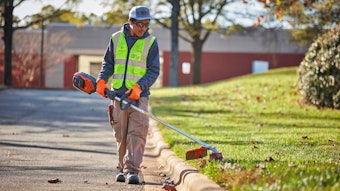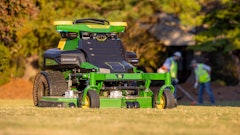
Driven by advancements in battery technology, data integration and autonomation, the mower industry has undergone significant changes in recent years, says Jeremiah Jennings, owner of Growing Green Landscapes in Birmingham, Ala.
“More businesses are embracing these innovations to enhance efficiency and growth,” Jennings says.
Naylor Taliaferro, owner and operator of Clean Cut Lawn Care in Midlothian, Va., adds that using this technology can increase the bottom line.
“There’s good technology out there that can help streamline the process and ultimately save time and labor,” Taliaferro says.
Mowing experts uncover more information on these top trends and provide insight into how landscape professionals can best use them to their advantage.
Driven by data
These days, mowers can come equipped with technology that does much more than simply mow—it’s all about the data.
For example, systems such as John Deere’s Operation Center provide real-time monitoring for mowers and equipment, says Jennings
“It’s already a valuable tool for managing mowing operations by providing real-time data on machine efficiency, usage patterns and potential areas for optimization,” Jennings says. “The bottom line is heavily impacted by it. It provides precise data on mower run time, stationary versus active periods and much more.”
Naylor Taliaferro, owner and operator of Clean Cut Lawn Care, in Midlothian, Va., adds that the technology can also help companies keep track of maintenance schedules. Clean Cut Lawn Care makes use of Toro’s Horizon 360 to keep track of invoicing, run time, equipment location and more.
“You can also see where they are at all times—you can track them and know when they go on and off the property,” Taliaferro says.
To make the most of this technology, Jennings recommends ensuring a strong and reliable connection to whatever software is being used and keeping the modem clean and properly maintained to guarantee consistent connectivity.
All in all, fleet optimization is key to maximizing productivity and controlling costs.
“It helps businesses identify inefficiencies by analyzing usage data, allowing for smarter decision-making when it comes to equipment investments,” Jennings says.
Easing into electric
While battery technology is advancing, Jennings says adoption in commercial mowing remains in the early stages, although it currently holds a lot of promise for handheld landscaping tools such as trimmers and blowers.
“Battery technology will be a game-changer—especially for businesses in high-traffic or vacation areas where mowing needs to be quiet and unobtrusive for guests,” Jennings says. “Alternative power sources may present long-term savings, and businesses should carefully evaluate total cost of ownership, including charging infrastructure and runtime efficiency, before making a transition.”
Taliaferro adds that as battery-powered equipment has become more prevalent, power, run time and charging time have improved.
“The commercial products in the field are getting more comparable to gas products, making it easier for contractors to convert,” Taliaferro says, adding that his company has started out using battery-powered push mowers before making the jump into larger mowers.
He notes that in the future, specific clients may request companies that utilize battery power.
“There is a client out there who wants clean energy,” Taliaferro says. “With battery equipment, you don’t have to worry about noise, fumes coming out of the equipment, accidentally spilling gas or oil or even mixing the gas and oil.”
While clients will enjoy the cleaner equipment, Taliaferro also says crew members also benefit from fewer fumes, less overall maintenance, less noise, a lighter weight and fewer vibrations.
“It’s better for the people using the equipment and for the people that are around when the equipment’s being used,” Taliaferro says. “There’s also a cost savings in the end because while there’s an initial upfront expense, there’s a lot less maintenance and you don’t have to spend as much on gas, oil and parts replacements like filters and spark plugs.”
A side effect of less maintenance, Taliaferro says, is less downtime, which means that crews are doing more billable work for a longer period of time, and companies are not spending payroll on as many maintenance techs, increasing the bottom line.
When it comes to integrating battery-powered tools into a landscaping fleet, additional planning is required, particularly around charging infrastructure and runtime management, Jennings says.
Taliaferro agrees, recommending that landscape pros consider the following questions:
· Where will the equipment be charged?
· How will the equipment be charged?
· How will you hold crews accountable, so they don’t forget to charge equipment?
· What’s the backup plan if someone does forget to charge equipment?
Clean Cut Lawn Care’s backup plan, Taliaferro says, is to keep extra charged batteries at the shop.
Having charging capabilities in trucks or trailers can also help avoid downtime, Jennings says.
Taliaferro also recommends having the right systems in place before undergoing such a transition from gas to battery power.
“Most folks are trying to transition one crew at a time instead of replacing everything at once because there is an upfront cost,” Taliaferro says. “You have to budget for that and make sure you have the timelines in place and can replace the equipment.”
He also stresses that crews need to be properly trained on the equipment.
“You definitely have to have training in place during that transition and then follow up as there’s a learning curve as everyone transitions,” Taliaferro says.
Autonomy assist
Another emerging solution, assisting landscape pros with their heavy workloads, is autonomous mowers.
“We anticipate significant growth in autonomous mowing, particularly for large-scale open areas,” Jennings says. “While adoption timelines may vary, advancements in automation have the potential to reshape commercial landscaping by improving efficiency and reducing labor challenges.”
Matt Moore, director of sales for Sunseeker Robotics, agrees that with the labor shortage that currently plagues the green industry, robotic mowers can help ease that strain.
“These mowers are not replacing people because you still need qualified people to install and support them, but it really allows the landscapers to reappropriate the labor they have into other items, whether it's enhancements or higher-margin work,” Moore says.
Taliaferro agrees that as labor becomes harder to find, mowers can help landscape pros build their business in the meantime.
“You may only need to send one person out to make sure the mower is all set up and ready to go, and then they can do the trimming and edging—the detail work—every week, so they’re spending a fraction of the time on property,” Taliaferro says.
Top advice
Before purchasing any of this equipment, it’s important that landscape pros first do their homework.
“Investing in the right equipment with strong dealer support and a solid warranty from the start is crucial,” Jennings says. “Downtime is lost time.”
Taliaferro adds that education and collaboration are two additional keys to success when it comes to technology implementation.
“Whether it’s reading an article, watching a video or listening to a podcast, there are so many ways to familiarize yourself with industry trends,” Taliaferro says. “You can also communicate with different brands at their booths at trade shows and demo some of the products. You can talk to the engineers and sales teams and get all your questions answered.”


























